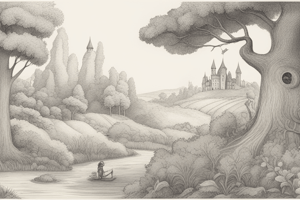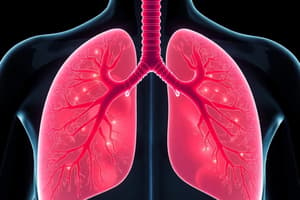Podcast
Questions and Answers
What is the primary function of the capillaries in the lungs?
What is the primary function of the capillaries in the lungs?
- To exchange gases between oxygen and carbon dioxide (correct)
- To transport nutrients from the digestive system
- To provide structural support to lung tissue
- To filter air before it enters the lungs
Which structures form the pathway that air travels through when breathing in?
Which structures form the pathway that air travels through when breathing in?
- Diaphragm, Esophagus, and Bronchi
- Alveoli, Larynx, and Diaphragm
- Pharynx, Trachea, and Bronchi (correct)
- Lungs, Alveoli, and Nasal Cavity
What purpose do the ciliated cells lining the nasal cavity and trachea serve?
What purpose do the ciliated cells lining the nasal cavity and trachea serve?
- To enhance the voice during speaking
- To assist in gas exchange with the blood
- To filter and trap particles before reaching the lungs (correct)
- To secrete enzymes for digestion
What is the role of the diaphragm in respiration?
What is the role of the diaphragm in respiration?
How long would the total length of capillaries in the lungs extend if laid end to end?
How long would the total length of capillaries in the lungs extend if laid end to end?
What is the primary function of the epiglottis?
What is the primary function of the epiglottis?
What role does the larynx play in the respiratory system?
What role does the larynx play in the respiratory system?
How does the diaphragm contribute to the breathing process?
How does the diaphragm contribute to the breathing process?
What is the primary function of the alveoli in the lungs?
What is the primary function of the alveoli in the lungs?
What happens to the chest cavity during exhalation?
What happens to the chest cavity during exhalation?
Flashcards are hidden until you start studying
Study Notes
Overview of the Respiratory System
- The respiratory system is responsible for supplying oxygen to body cells and removing carbon dioxide.
- It involves inhalation (breathing in) and exhalation (breathing out) processes.
Capillaries in the Lungs
- Approximately 200 million capillaries exist in the lungs, extending up to 1,500 miles in total length.
- Capillaries facilitate gas exchange, allowing oxygen to enter and carbon dioxide to leave the bloodstream.
Pathway of Air
- Air enters through the nose, moves through the nasal cavity, and passes into the pharynx (throat).
- From the pharynx, air travels through the epiglottis and larynx (voice box) into the trachea (windpipe).
- The trachea splits into two bronchi, leading air directly into the lungs.
Filtration of Air
- The nasal cavity, trachea, and bronchi are lined with ciliated cells that secrete mucus to trap and remove particles from inhaled air.
Main Structures of the Respiratory System
- Lungs: Major organ where gas exchange occurs; sponge-like structure allowing gas movement.
- Diaphragm: Muscle separating thorax from abdomen; contracts to draw air in and relaxes to expel air.
- Pharynx: Connects nasal cavity and mouth to larynx and esophagus; part of the alimentary canal.
- Epiglottis: Flap covering glottis during swallowing to prevent food from entering the trachea.
- Larynx: Organ controlling breath and sound production; houses the vocal cords and protects the trachea.
- Trachea: Cartilaginous tube connecting larynx to bronchi (windpipe).
- Bronchi: Primary airways branching from trachea into each lung.
Inside the Lungs
- Bronchi branch into smaller tubes called bronchioles, ending in tiny sacs named alveoli.
- Alveoli: Sites for gas exchange through diffusion; oxygen enters blood and carbon dioxide exits to be exhaled.
Breathing Process
- Breathing is a mechanical activity involving diaphragm and intercostal muscles.
- During inhalation, rib muscles contract and the diaphragm flattens, increasing chest cavity volume and drawing air in.
- During exhalation, rib muscles relax, decreasing chest cavity volume and forcing air out from alveoli.
Studying That Suits You
Use AI to generate personalized quizzes and flashcards to suit your learning preferences.




